BestReviews is reader-supported and may earn an affiliate commission. Details
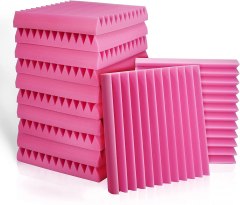
Take your recording quality from good to legendary with these studio-grade panels.
Take your recording quality from good to legendary with these studio-grade panels.
These professional-grade wedges are 2 inches thick. Engineered to turn sound waves into energy and to minimize sound amplification/reverb in decoupled walls. Several great colors available.
Pricier than some other choices, although users say it is worth the investment.

This multipurpose option helps you control reverb, get the perfect echo, and isolate sounds.
This multipurpose option helps you control reverb, get the perfect echo, and isolate sounds.
The square, wedged material absorbs the sounds. Great set to practice different setups without spending too much. The polyurethane is remarkably tough and lightweight.
Some inconsistency in sizes. Some find it hard to soak them.
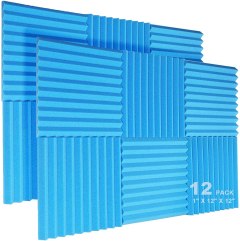
A spot treatment for offices, game rooms, recording studios, and makeshift setups.
A spot treatment for offices, game rooms, recording studios, and makeshift setups.
Can be cut and shaped to suit your space as needed. Suitable for spaces where voice and video are recorded. Affordable squares. Available in 3 color choices for those going for specific looks.
Best for small to medium-sized rooms: not ideal for larger spaces.
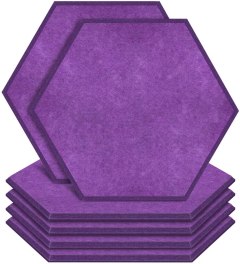
Unique hexagonal shapes made of odorless, free-of-formaldehyde, flame-resistant polyester.
Unique hexagonal shapes made of odorless, free-of-formaldehyde, flame-resistant polyester.
Absorb sound from recording studios to dog kennels. Easy installation with double-sided tape means everything you need is there. Won't leave stickiness. Great for professionals.
The number of panels per purchase is fairly low.
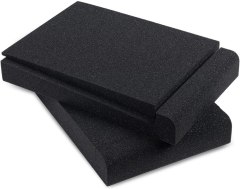
They fit with most leading brands of speakers for optimal sound quality and results.
They fit with most leading brands of speakers for optimal sound quality and results.
Fit under most 5-inch speakers. Help control the sounds and keep them in the studio. Simple design lets those who understand acoustics get custom results depending on placement.
Built for desks, might not be ideal for some setups.
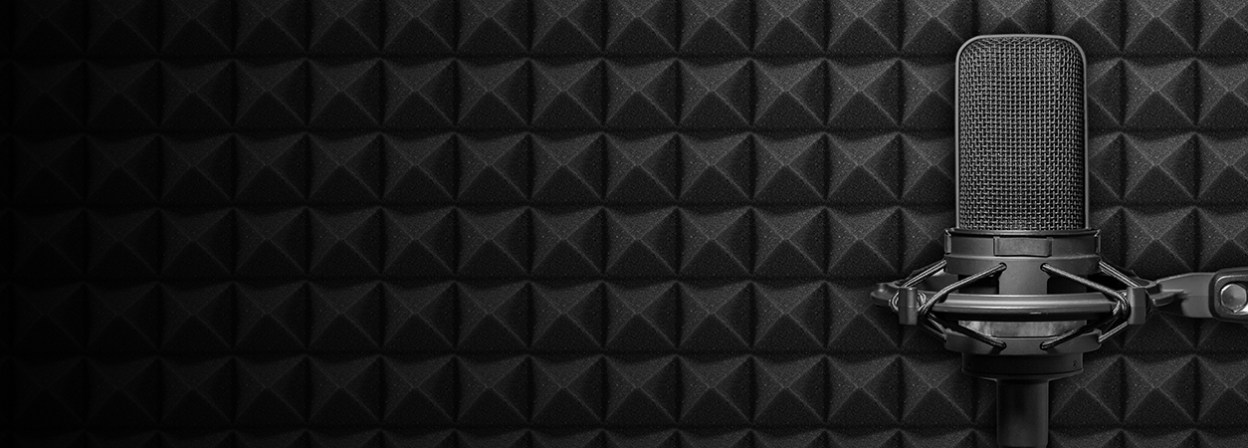
We recommend these products based on an intensive research process that's designed to cut through the noise and find the top products in this space. Guided by experts, we spend hours looking into the factors that matter, to bring you these selections.
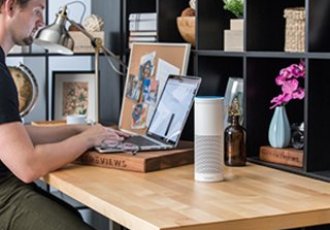
Acoustic foam is a porous material you attach to walls. Instead of bouncing sound back into the room, it absorbs the sound into the material and, via friction, turns it into heat. If you’re a recording artist looking for a way to improve the acoustics in your studio, you need acoustic foam panels for your walls.
When recording, your goal is to capture the source of the sound, whether that sound is a speaker, singer, or instrument. Unfortunately, the structure of your recording space can get in the way of this goal, bouncing all sorts of reverberation back at your mic and covering the original sound with extra, unnatural material.
Even if you aren’t looking to maximize sound quality for recording purposes, you might be interested in foam panels, which reduce the amplitude of sound waves and noise pollution by absorbing sound. In other words, acoustic foam can make the sound in a room less harsh and more gentle on the ears and is often used in deluxe home theaters, restaurants, and other crowded places.

Before investing in these colorful foam panels, it helps to understand why you might need them in the first place. Here is a list of common acoustic problems you can address with quality acoustic foam:
Reflection: If you try to record in an uncarpeted room with hard, bare walls, the sound reflects off the hard surfaces and back into your microphone. The solution to this is absorption is placing something on the hard surfaces to soak up the sound rather than bounce it back.
Reverberation: Often referred to as “reverb,” this is the gradual decay of sound, both reflected and original. When it bounces off flat surfaces (like walls and hard flooring) and comes back to your microphone, it can create an unwanted, unprofessional sound.
Flutter echo: This occurs when sound rapidly bounces from one wall to the opposite wall. It is common in small, untreated rooms, but it can also be heard in large gymnasiums and long hallways. It has been described by some listeners as a “flutter,” while others describe it as a hollow, tunnel-like sound.
Standing waves: When reflected sound waves collide, they can create standing waves. Standing waves are not visible, but they are very much barriers that can alter the frequency in various parts of the room, creating peaks and dips where you don’t want them. Standing waves occur in rooms with four to six walls that bounce sound back and forth. With acoustic foam, you can intercept some of the “bounce” so standing waves are less likely to occur.
Your acoustic foam needs to be mounted on the wall with a reliable adhesive. Some people use adhesive tape placed carefully in all four corners and the center of each panel. Others use 3M Command Strips, which are designed to not ruin the paint on the walls.
A few acoustic foam products we found in our research come with a peel-off backing. This is highly convenient: simply peel the paper off the foam and place each panel where you want it. As always, read the directions before applying, and make sure your chosen adhesive has a good reputation for leaving walls (and wall paint) unscathed.

The thickness of acoustic foam matters and your selection should be based on the types of sound you create and want to temper.
The thinnest acoustic foam panels may only absorb high-frequency sound waves. Thicker foam is more likely to absorb high-, mid-, and low-frequency sound waves. The reason is that lower frequencies have longer waves that, in order to be fully absorbed, must be caught by a thicker material.
Look at an acoustic foam’s Noise Reduction Coefficient (NRC) to determine its effectiveness.
Wedges: Wedged foam is “spiky” foam. Smaller spikes tend to absorb less sound in larger rooms. If you want spiked wedges in a larger room, opt for larger spikes.
Pyramids: This type of foam has pointier spikes than wedge foam, but like wedge foam, the size of the pyramids should correspond with the size of the room.
Eggcrates: Instead of foam spikes, these panels have nubs with rounded edges. The texture is subtler than that of wedges and pyramids.
Grids: This type of foam has raised lines on a flat surface. The lines can redirect sound for better absorption. Like eggcrate foam, the texture is subtler than that of wedges and pyramids.
When you order acoustic foam panels, they will most likely arrive in squares (12 by 12 inches is common) that you can trim down with scissors or a sharp knife to fit your space as you see fit. However, instead of square panels, you might choose hexagonal panels. These fit together in a honeycomb pattern on a wall. In most cases, hexagonal panels can also be trimmed down to fit the dimensions of your space.
A bass trap is a type of acoustic foam. It isn’t the primary focus of this article, but it’s worth mentioning because you might want to invest in bass traps for your recording studio.
Every room has its own naturally occurring frequency, which is sometimes referred to as modal resonance. “Boominess” in the low ranges is a typical problem caused by modal resonance. Bass traps are specifically designed to absorb the low-frequency sound that contributes to boominess.
Bass traps can be up to 6 inches thick. They’re often positioned in tricornered locations, such as where two walls meet the ceiling. However, some people elect to place bass trap wedges in regular (non-tri) corners or thick bass trap panels on walls or ceilings.
If you want to make a recording and only have a few acoustic foam panels, move your setup to a carpeted room with curtains and large pieces of furniture (such as a bedroom). Coupled with the foam you have, these items can share the load of absorbing reflected sound waves.
When assessing the worth of acoustic foam, one of the most important things to consider is how well the foam absorbs sound. Thickness plays a role in this, as does the quality of the material and the texture of the foam.
Another factor to consider is the number of panels you get per order. Many companies sell their panels in packs of 12 squares that are 1 foot tall and 1 foot wide. However, some companies sell panels of the same size in sets of 6. Faced with a choice between a 12-pack for $20 and a 6-pack for $20, the less costly deal is obvious if you do a little comparing first.
Inexpensive: The least expensive options of good quality tend to cost around $20 for a pack of 12 squares. That amounts to approximately $1.66 per square. Often, these solutions are on the thin side (around 1 inch or less) and best for smaller rooms.
Mid-range: For just a little bit more per panel ( $2 or $3), you can get acoustic foam that is 2 to 3 inches thick. These panels are found in 12-packs, 25-packs, and larger quantities as well.
Expensive: With acoustic foam, a higher price can often be attributed to a higher quantity. For example, a pack of 50 tiles at $3 apiece would be $150. Some companies do sell their pieces for up to $5 each, which means a set of 50 would cost around $250. Note, however, that many recording artists find satisfaction with well-placed pieces that cost $2 to $3 each.


A. No. Even if you were to cover your walls with acoustic foam, some sound would bleed through to the next room (and beyond) if you decided to blare your music at top volume. Soundproofing requires multiple layers of weight and mass, not just several inches of foam.
A. No. Just as acoustic foam can’t prevent indoor sound from bleeding out, it can’t prevent outdoor sound from seeping in. If you’re troubled by ambient noise while trying to sleep, consider a white noise machine or earplugs designed specifically for sleeping.
A. You could, but packing foam isn’t engineered to absorb sound. Rather, it’s engineered to protect the things you pack inside it. Acoustic foam isn’t expensive, and when strategically placed to eliminate common acoustic problems like reverberation and flutter echo, it does its job well.
Get emails you’ll love.
Learn about the products you’re wondering if you should buy and get advice on using your latest purchases.
